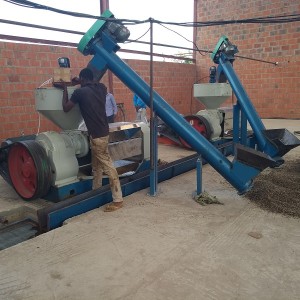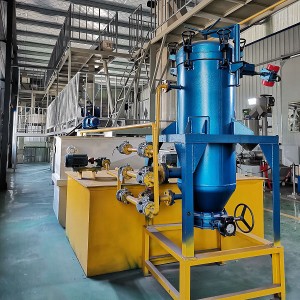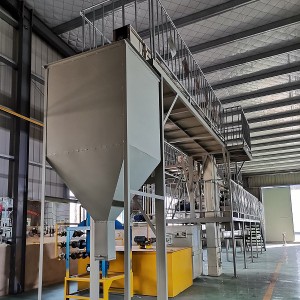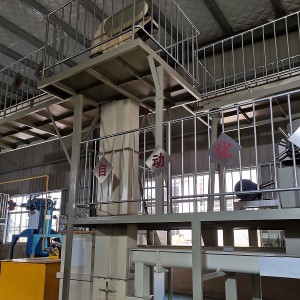Palm Oil Pressing Line
Description
Palm is grow in Southeast Asia, Africa, south pacific, and some tropical area in South America. It originated in Africa, was be introduced to Southeast Asia in the early 19th century. The wild and half wild palm tree in Africa called dura, and the by breeding, develop a kind named tenera with high oil yield and thin shell. From the 60s last century, almost all the Commercialized palm tree is tenera. Palm fruit can be harvested throughout the year.
The Fruit office include palm oil and fiber, and kernel is mainly constituted by High valuable kernel oil, Amylum, and Nutritional Components. The palm oil is mainly for cooking and Palm kernel oil is mainly for cosmetics.
Technology Process Specification
The palm oil is contained in palm pulp, the pulp is high moisture content and rich lipase. Usually we adopt the method of press to produce itand this technology is very mature. Before pressing, Fresh fruit bunch will be taken into sterilizer and thresher to be pre-treated. After weighting the FFB, it is loaded the FFB conveyor by loading ramp, then the FFB will be conveyed to the vertical sterilizer. FFB will be sterilized in sterilizer, the FFB will be heated and sterilized for several times to avoid the lipase being hydrolyzed. After sterilizing, the FFB is distributed bunch conveyor by the mechanical bunch feeder and enter the thresher machine which separates the palm fruit and bunch. The empty bunch is conveyed to loading platform and transport it to outside the factory area at fixed period , the empty bunch could be used as fertilizer and repeat use; The palm fruit which has passed sterilizer and thresher processing should be sent to digester and then go to special screw press to get the crude palm oil (CPO) from the pulp. But the pressed palm oil contain a lot of water and impurity which need to be clarified by sand trap tank and treated by the vibrating screen, afterward the CPO will be sent to clarification station treatment section. For the wet fiber cake which be produced by screw press, after separating nut, it will be sent to boiler house to burnt.
The wet fiber cake contain wet fiber and wet nut, the fiber contain about 6-7% oil and fat and a few of water. Before we pressing the nut, we should separate the nut and fiber. Firstly, the wet fiber and wet nut enter the cake breaker conveyor to be cracked, and mostly of the fiber should be separated by pneumatic fiber depericarper system. The nut, little fiber and big impurity will be further separated by the polishing drum. The separated nut should be sent to nut hopper through the pneumatic nut transport system, and then adopt the ripple mill to crack the nut, after cracking, most of the shell and kernel will be separated by cracked mixture separating system, and the rest of mixture of kernel & shell enter to the special clay bath separating system to separate them. After this processing, we could get pure kernel(The shell content in kernel <6%),which should be conveyed to the kernel silo to dry. After dried moisture as 7%, the kernel will be conveyed to kernel storage bin for storage; Usually the dry kernel’s capacity ratio is 4%. So it should be collected until enough quantity, and then be sent to the palm kernel oil mill; For the separated shell, it should be conveyed to shell temporary bin as the spare boiler fuel.
After screen and sand trap tank, the palm oil should be sent to crude oil tank and heat, then be pumped continuous clarification tank to separate the purified oil which be sent to pure oil tank and the sludge oil which be sent to sludge tank , where after the sludge oil should be pumped to the centrifuge to separate, the separated oil enter the continuous clarification tank again; The pure oil in the pure oil tank should be sent to the oil purifier, and then enter the vacuum dryer, at last the dried oil should be pumped collection tank.
Technical Parameters
| Capacity | 1 TPH | Oil extraction rates | 20~22% |
| Oil content in FFB | ≥24% | Kernel content in FFB | 4% |
| shell content in FFB | ≥6~7% | Fiber content in FFB | 12~15% |
| Empty bunch content in FFB | 23% | Press cake proportion in FFB | 24 % |
| Oil content in empty bunch | 5 % | Moisture in empty bunch | 63 % |
| Solid phase in empty bunch | 32% | Oil content in press cake | 6 % |
| Water content in press cake | 40 % | Solid phase in press cake | 54 % |
| Oil content in nut | 0.08 % | Oil content in wet meter heavy phase | 1% |
| Oil content on meter solid | 3.5% | Oil content in final effluent | 0.6% |
| Fruit in empty bunch | 0.05% | Total in losses | 1.5% |
| Extraction efficiency | 93% | Kernel Recovery efficiency | 93% |
| Kernel in empty bunches | 0.05% | Kernel content in cyclone fiber | 0.15% |
| Kernel content in LTDS | 0.15% | Kernel content in dry shell | 2% |
| Kernel content in wet shell | 2.5% |













